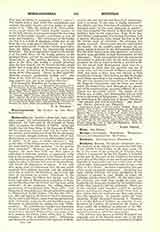

Homoousion (Gr. omooumion—from omos, and ousia, essence; Lat. consubstantialem, of one essence or substance), the word used by the Council of Nicaea (325) to express the Divinity of Christ. Arius had taught that the Son, being, in the language of Philo, the Intermediator between God and the world, was not eternal, and therefore not of the Divine substance, but a creature brought forth by the free will of God. Homoousion was indeed used by philosophical writers to signify “of the same or similar substance”; but, as the unity of the Divine nature was not questioned, the word carried the fuller meaning: “of one and the same substance”. However, not only is omos ambiguous; the word ousia itself was often taken as equivalent to upostasis (person), as apparently is the case in the anathema attached to the Nicene Symbol. And therefore the affirmation of the identity of nature might be taken in the heretical sense of the Sabellians, who denied the distinction of person. It was only after many years of controversy that the two words acquired their distinct meanings, and the orthodox were able to describe the Trinity as one in ousia and three in hypostasis or persona. Previously to the Council of Nica, Tertullian had already used the Latin equivalent of Homoousion, conceding to Praxeas the Sabellian that the Father and Son were unius substantice, of one substance, but adding duarum personarum, of two persons (Adv. Prax., xiii). And Dionysius of Alexandria used the actual word in a letter to Dionysius of Rome (Athan., “De dec. Syn. Nic.”, xxv, 26), and again in his letter to Paul of Samosata. On the other hand, Origen, who is, however, inconsistent in his vocabulary, expresses the anti-Sabellian sense of Dionysius of Alexandria by calling the Son “Heteroousion”. The question was brought into discussion by the Council of Antioch (264-272); and the Fathers seem to have rejected Homoousion, even going so far as to propose the phrase eteras ousias, that is, Heteroousion, “of other or different ousia”. Athanasius and Basil give as the reason for this rejection of Homoousion the fact that the Sabellian Paul of Samosata took it to mean “of the same or similar substance”. But Hilary says that Paul himself admitted it in the Sabellian sense “of the same substance or person”, and thus compelled the council to allow him the prescriptive right to the expression. Now, if we may take Hilary’s explanation, it is obvious that when, half a century afterwards, Arius denied the Son to be of the Divine ousia or substance, the situation was exactly reversed. Homoousion directly contradicted the heretic. In the conflicts which ensued, the extreme Arians persisted in the Heteroousion Symbol. But the Semi-Arians were more moderate, and consequently more plausible, in their Homoiousion (of like substance). When one considers how the four creeds formulated at Antioch (341) by the Semi-Arians approached the Nicene Creed as nearly as possible with-out the actual word Homoousion, there may be a temptation to think that the question was one of words only; and the Councils of Rimini and Seleucia (359) may seem to have been well advised in their conciliatory formula “that the Son was like the Father in all things, according to the teaching of Holy Writ”. But this very formula was forced from the Fathers by the Emperor Constantius; and the force and fraud which the Semi-Arians used throughout the greater part of the fourth century, are proof sufficient that the dispute was not merely verbal. The dogma of the Trinity was at stake, and Homoousion proved itself to be in the words of Epiphanius “the bond of faith”, or, according to the expression of Marius Victorinus, “the rampart and wall of orthodoxy.” (See Arianism; Councils of Nicaea; The Blessed Trinity.)
JAMES BRIDGE

